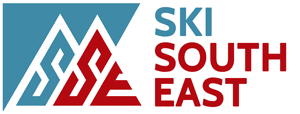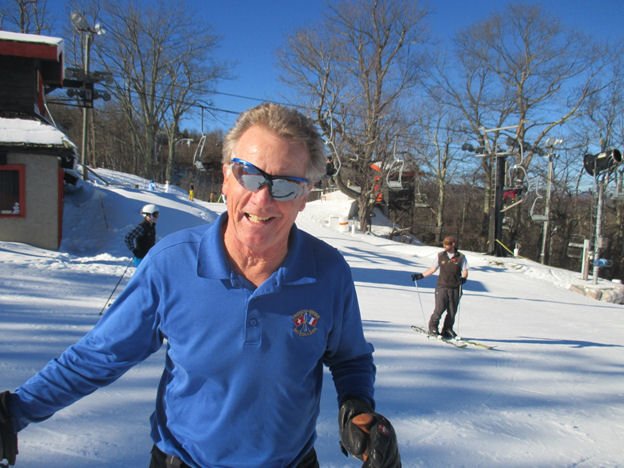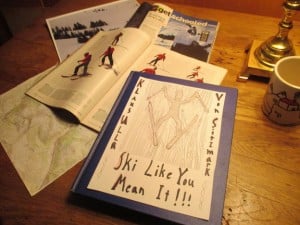
Martin Luther King weekend is upon us and every resort in the area is open and steadily increasing their trail count. Frankly THIS feels more like the start of the ski season. Winter 2015 was just a bad dream so wake up now, have a cup of coffee and start making your plans. High on your list of plans should be ski lessons, whether for yourself, your children or your beloved partner.
January is Learn to Ski & Snowboard Month and the Southeast resorts are among the best places to start. The size and terrain of many of our ski areas make them ideal training grounds and instruction is one of the primary focuses of most operations. In other words they are there waiting and ready for you. I want to spend some time on that topic and share my own experience; yes being a true journalist I did some background research and actually took a lesson myself. I was lucky enough to do that one-on-one with Jim Cottrell, the founder of the French-Swiss Ski College. I quote him at some length later because the conversation was so interesting and I felt what he said was not just specific to my dubious technique but useful to any skier with basic skills. Also for those foolish enough to be interested check the SkiSoutheast Message board – TheMcCueMethod – for my own ideas about a radical instruction method. (You can CLICK HERE to go right to the thread.)
Don’t be “that guy”
Have you ever sat on the patio of a base lodge and watched in amazement as a skier flailed wildly down a crowded slope toward certain catastrophe? A blurred outline with a flapping coat and a trail of hat and goggles rockets downhill nearly seated in a snow plow position; which, against all laws of physics, is actually causing him to accelerate. Sensing danger, the crowd parts before him and he finally plunges head first into a fully stacked equipment rack triggering an avalanche of skis, snowboards and unwitting bystanders. Don’t be that guy.
Or have you ever seen a couple, one of them an “experienced” skier (usually a male), trying to assure a furious partner that she “can do this” but staying just out of reach of a pole swing? That is no way to build a relationship; although, if you are trying to get out of a relationship, it can be an excellent start.
And of course there is always the parent (usually a Dad) chasing madly after a small frightened child, pointlessly yelling “Pizza! Pizza!! PIZZA!!!” as their son or daughter flies off the trail’s edge and into the trees? Is that how you want to be remembered? You will give your children plenty of fodder for therapy in years to come without also wrecking their vacations.
Add Value to Your Vacation
As we all know, skiing is not cheap. The fact that so many of us do it despite that cost is a testament to how amazing it is, and it remains considerably cheaper than flying lessons. The cost of ski instruction is negligible in the overall balance of a ski trip and is a certain way to improve the experience. If you are a parent this is truly a no brainer. Speaking from personal experience not only did my sons learn much faster than they would have with me, but it breaks up the day. It was an added dose of cocoa and fun that we would talk about and build on during our later runs together. It made them much better, much quicker and they were positively beaming about their new skill. As for adults, if you’ve never skied you should do everything you can to make things as painless as possible, those first days can be…let’s just say challenging. If you already know how to ski remember that even World Cup athletes have coaches, and probably no one reading this is a World Cup skier, at least not yet.
A few timely tips
DO be a line cutter. Have you ever noticed while waiting in a long lift line that some people are getting special treatment? There you stand with your toes getting cold and off in the distance right by the lift shack small groups of common looking skiers are just skiing right onto the lift. Those people are the ones taking a lesson, and not only are they getting better than you but thanks to their ski school status they are making way more laps. This is a benefit especially valuable during busy times like the approaching MLK weekend and can be maximized with a private lesson.
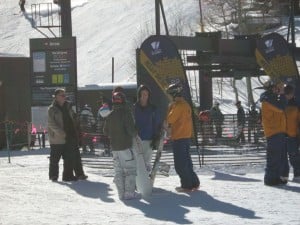 Another piece of voodoo is the private/group lesson; this magical phenomenon only occurs on slower days, especially weekday mornings. If you head to the scheduled group lesson meeting area and happen to be the only one there you get the benefit of having the instructor all to yourself, and on midweek mornings most of the mountain to yourself as well. This happened for my sons’ first lessons at Cataloochee. Later when they were teenagers during their first trip to Colorado, they ended up spending a half day morning lesson alone with an amateur free style champion who was instructing at Winterpark; it almost felt like cheating.
Another piece of voodoo is the private/group lesson; this magical phenomenon only occurs on slower days, especially weekday mornings. If you head to the scheduled group lesson meeting area and happen to be the only one there you get the benefit of having the instructor all to yourself, and on midweek mornings most of the mountain to yourself as well. This happened for my sons’ first lessons at Cataloochee. Later when they were teenagers during their first trip to Colorado, they ended up spending a half day morning lesson alone with an amateur free style champion who was instructing at Winterpark; it almost felt like cheating.
And always, TIP YOUR INSTRUCTOR; as a rule they do not make a lot and rely on those tips. Personally, I have never seen anything but smiles and positive attitudes on the part of the ski school staffs at southeastern resorts so I’d say they deserve it.
There it is, I’ve made my case for taking a lesson and because I wouldn’t want to be called a hypocrite; I took my own advice.
Jim Cottrell at Appalachian Ski Mountain
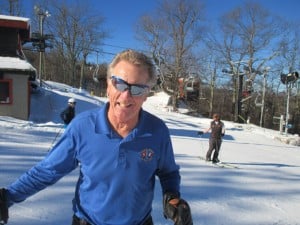
If I ever took a lesson in my childhood, four decades of face plants and low hanging tree limbs have knocked the memory clean. For years I have toyed with the idea of mending this, if only to determine whether in fact an old dog can learn new tricks; but laziness and inertia always got the better of me. Also, I am not particularly amenable, I have always had difficulty with anything that resembled a mentoring relationship, and I generally don’t follow instructions well.
With that in mind I asked Mike Doble if he knew of someone in the area that might undertake the challenge “of an older skier somewhat set in his ways”. Perhaps sensing this would be a demanding task, he suggested one of the pioneers of southeastern ski instruction, Jim Cottrell (Jim, now you know who to blame). So I contacted him and was somewhat nervous when he responded immediately and said he would love to help. This was an intimidating prospect because Jim is truly the real deal and if he couldn’t help me I knew my case was hopeless.
Jim Cottrell and his friend Jack Lester founded the French-Swiss Ski College at Appalachian Ski Mountain in 1968, which is now an icon of Southeastern skiing. Jim has integrated skiing into college credited courses for decades, taught skiing to Green Berets and Navy Seals. He counts among his friends two heroes of mine, Jean-Claude Killy and Billy Kidd; he and Kidd served on the International Advisory Board for Special Olympics and have taught clinics together. Cottrell organized the first North Carolina Winter Special Olympics and Special Olympics and its instruction is a passion that comes up often in conversation. I would add that this is a very partial list of his impact on skiing here and nationally, and he was reluctant to dwell on his achievements even when asked. To spend the better part of an afternoon learning from Jim, and just sharing conversation, was a rare experience; first hand stories and tips from Killy and Kidd were also high on the scale of Awesome.
This was all last Thursday and a bonus was that I made my first visit Appalachian Ski Mountain which had reopened 100% of its trails that day.
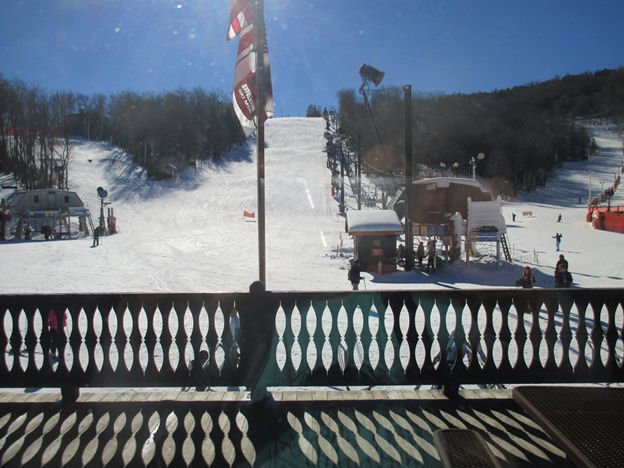
I have to say too that App is an ideal learning mountain. The consistency of the snow on the main slope even after an afternoon of warming was flawless. Also, while it was not a crowded day, the ratio of Instructors moving around the slope ready to teach was sort of mind boggling; as in the picture above that I took of Jim, notice that the two random people you see in the background are both instructors. If I shouted “Help I need a lesson,” I might have been buried in a sea of uniformed French-Swiss staff.
I recorded most of our session. Jim is very considerate and thoughtful in what he has to say so I’m glad I have it down accurately, although some audio I lost to wind and lift clatter. That is something I’d urge anyone to do, record your lesson for future reference; if you own a GoPro this would be a perfect time to use it; it will be a lot more illuminating than the next rad park edit.
First thing we did was an assessment run. Basically he followed me and I self-consciously made my way down trying my best to look proficient. I was deeply gratified by his initial assessment:
“Now you have good skills. You have good balance, you rotor the skis really well, you’ve got good edging skills and you pressure the skis well.” Booyahh!!! Greatness! “I think we would like to tweak your balance and what you do with your hands and the next thing is going to be your turn shape. But you have all the skills.”
Later I realized that this is the mark of a good teacher, making you feel positive about yourself so you have the enthusiasm and desire to improve. In retrospect I realize a translation might have been, “Well you didn’t actually fall over and you never accidentally stabbed me in the eye with your pole. I can work with this.”
And work with me he did. I have always wondered how much difference a lesson could make for a long time skier, but I have to say that at least with a teacher of Jim’s caliber, it can make an immediate improvement; and I want to keep working on what I learned as soon as I’m back on the slopes. A lot of what he told me was obviously subjective but I think a great deal of it is useful to anyone with intermediate skills. So let me share several of his specific remarks.
First, like a lot of people who can ski steep terrain (though not particularly well), I was relying too much on a sharp checking style of turn:
“The turn shape that you have is for steeper terrain and on more moderate terrain you don’t need that much turn in it, and you were controlling your speed through a check now what I would like to focus on with you is going to be tweak your balance with your hands a little bit and change your turn shape so we control your speed with the shape of the turn as opposed to a check … Your turn has a lot of hard rotations as opposed to riding the ski around whether it’s skidding or carving is irrelevant, using the turn shape takes the strain out of skiing.”
Another specific was addressing the fact that I hold my hands much too close to my body:
“You will have better balance if you spread them out and keep them forward, you need a gap between your arms and your body, it makes everything easier… The term I like to use is open the frame…Watch Olympic ice skaters, when they want to spin they bring their arms close in and to slow they bring their arms out, same when you ski, if your arms are real close every time you move your hands you move your shoulders. When you’re hands are out here [open and forward] you can do all kinds of stuff and your shoulders don’t move. And you’re hands should reflect the pitch of the slope … they should move with your eyes in the direction of the turn, you look where you want to turn.”
He also addressed my questions about using poles effectively:
“OK, I’m not planting the pole but I’m making the movement of the hand that pulls the shoulder. You don’t need the pole plant with the skis anymore. Now, if you are on something really steep, and you’re trying to give yourself something to pivot around or to block the turn and stop it so to speak then you plant the pole as a fulcrum to turn around. I did a clinic with Billy Kidd at Steamboat, he and I were on the International Advisory Board for Special Olympics so I’ve known him for years and what he talked about was stance, he said what you need to think about is, well if you think about those Olympians there is an aggressive athletic stance with their hands moving forward and looking way down the hill it’s an athletic aggressive posture, now no offense, but the beginners are like this, it’s not dynamic so if you want to get to a higher level of skiing all types of terrain and snow you need dynamic balance and that’s what we’re working on. And you don’t have to plant the pole you just have to move your arm with the pole as the lead into your next turn.”
An aggressive forward stance was a constant theme, as Jim put it you should try to press your leg through the front of your boot, coiling and uncoiling as you press through your turns. He illustrated this by again referencing race technique:
”Now when racers are going really fast, it looks like they are in the backseat, they’re not in the backseat, actually their knees are probably well past their toes they’re putting all that pressure on their front.”
“You don’t just press the leg straight towards the front of the boot and you don’t lean to the side, that’s too much; but there’s a place right between the two and if you’re wanting to go that way and you try to press the front of your leg through the boot it’s going to put you up on a little higher edge. It’s not twisting your ankle inside the boots, its pressing through the boot into your turn.”
He put all together very elegantly when I asked him about whether new ski technology has changed the technique:
“The skills are the same, the application is different. We still have balance, edging, rotation and pressure. With the longer skis we had to spend a lot of time really lifting the skis up with a lot of rotary now with the new technology with the flex and shape they build into the skis the application of those skills now is more relative to balance, the movements are more refined it takes less movement to accomplish the same thing. What we used to have to do was to work the skis around; getting people to a level where they could carve took many, many days on skis whereas the shaped skis allow people to get to that sensation of carving very early. Balance is still the biggest element if you get into balance on these new skis, skiing is really easy that’s the key and it’s not just balance but dynamic balance. What I mean by that is balance in motion and very few people have a problem balancing on the flat but get on an incline and it requires you maintain flex in your ankles and your knees to keep where you are perpendicular to your skis and the natural tendency is for people is to hug the back of the mountain rather than being offensive and being over it. What we try to teach here is offensive skiing instead of defensive; it’s not so much about stopping or slowing down all the time, it’s about controlling your speed through turn shape rather than braking.”
I could go on as it was an awesome experience and I hope it was valuable to share some his insights. Finally let me mention two videos Jim made and introduced me to. The first is an oddly Zen-like compression of the principles above: (Click to play the video. Be aware that the video was produced by French-Swiss Ski College and the formatting doesn’t fill the screen. It’s nevertheless pretty cool.)
And if you want a good exercise to keep yourself ski fit here is one Jim said he learned from Jean-Claude Killy and does every morning.
He said the focus was on core strength, that toning your gut was more important than your quads; I tried not to feel judged by that remark and I tightened my belt as inconspicuously as possible. Still, perhaps I should follow up and try some of the vegetarian recipes that Jim shared with his friend Jean-Claude back in the day. That change in diet apparently coincided with his post-Olympic World Cup run.
Thanks to Jim Cottrell and to all of you still following this …. Now go out and take a lesson!!
